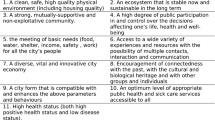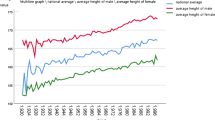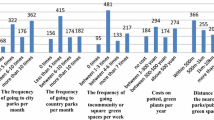Abstract
Self- assessed general health status is a commonly-used survey technique since it can be used as a predictor for several public health risks such as mortality, deprivation, and fear of crime or poverty. Therefore, it is a useful alternative measure to help assessing the public health situation of a neighborhood or town, and can be utilized by authorities in many decision support situations related to public health, budget allocation and general policy-making, among others. It can be considered as spatial decision problems, since both data location and spatial relationships make a prominent impact during the decision making process. This paper utilizes a recently-developed spatial intelligent decision system, named, Spatial RIMER+, to model the self-rated health estimation decision problem using real data in the areas of Northern Ireland, UK. The goal is to learn from past or partial observations on self-rated health status to predict its future or neighborhood behavior and reference it in the map. Three scenarios in line of this goal are discussed in details, i.e., estimation of unknown, downscaling, and predictions over time. They are used to demonstrate the flexibility and applicability of the spatial decision support system and their positive capabilities in terms of accuracy, efficiency and visualization.















Similar content being viewed by others
References
Sugumaran R. and DeGroote J.P., Spatial Decision Support Systems: Principles and Practices. CRC Press, 2010.
Ziersch, A., Neighbourhood ‘Social Infrastructure’ for Health: The Role of Social Capital, Fear of Crime and Area Reputation. In: Nriagu, J. O. (Ed.), Encyclopaedia of Environmental Health. Elsevier, Burlington, pp. 72–78, 2011.
Subramanyam, M., Kawachi, I., Berkman, L., and Subramanian, S. V., Relative deprivation in income and self-rated health in the United States. Social Science & Medicine 69(3):327–334, 2009.
Van Jaarsveld, C. H., Miles, A., and Wardle, J., Pathways from deprivation to health differed between individual and neighborhood-based indices. Journal of Clinical Epidemiology 60(7):712–719, 2007.
Benyamini, Y., Why does self-rated health predict mortality? An update on current knowledge and a research agenda for psychologists. Psychology & Health 26(11):1407–1413, 2011.
Jerant, A., Tancredi, D. J., and Franks, P., Mortality prediction by quality-adjusted life year compatible health measures: findings in a nationally representative US sample. Medical Care 49(5):443–450, 2011.
Malczewski, J., GIS‐based multicriteria decision analysis: a survey of the literature. Intl J. of Geog. Inf. Science 20(7):703–726, 2006.
Thomas, C., and Humenik, N., GIS for Decision Support and Public Policy Making. Calif.: ESRI Press, Redlands, 2009.
Sun, R., Robust reasoning: integrating rule-based and similarity-based reasoning. Artificial Intelligence 75(2):241–295, 1995.
Angelov P. and Yager R., A simple fuzzy rule-based system through vector membership and kernel-based granulation. Proceedings of 2010 I.E. Intl Conf. on Intelligent Syst., pp. 349-354, 2010, London, UK
Huysmans, J., Dejaeger, K., Mues, C., Vanthienen, J., and Baesens, B., An empirical evaluation of the comprehensibility of decision table, tree and rule based predictive models. Decision Support Systems 51(1):141–154, 2011.
Calzada A., Liu J., Wang H. and Kashyap A., A novel spatial belief rule-based intelligent decision support system. IEEE International Conference on Systems, Man and Cybernetics (IEEE SMC 2013), October 13-16, 2013, Manchester, UK: 639-644.
Lloyd C.D., Local Models for Spatial Analysis, Second Edition. CRC Press, Taylor and Francis Group, 2011.
Calzada A., Liu J., Nugent C., Wang H., and Martinez L. (2014), Using the spatial RIMER+ approach to estimate negative self-rated health and its causes across Northern Ireland, Proceeding of the 8th International Conference on Ubiquitous Computing & Ambient Intelligence (UCAmI 2014) & the 6th International Work-conference on Ambient Assisted Living (IWAAL 2014), Belfast, 2nd - 5th December 2014.
Liu, J., Martinez, L., Calzada, A., and Wang, H., A novel belief rule base representation, generation and its inference methodology. Knowledge-Based Systems 53:129–141, 2013.
Yang, J. B., Liu, J., Wang, J., Sii, H. S., and Wang, H. W., Belief rule-base inference methodology using the evidential reasoning approach – RIMER. IEEE Transactions on Systems, Man and Cybernetics – Part A 36(2):266–285, 2006.
Yang, J. B., and Xu, D. L., On the evidential reasoning algorithm for multiple attribute decision analysis under uncertainty. IEEE Transactions on Systems, Man and Cybernetics – Part A 32(3):289–304, 2004.
Calzada A., Liu J. and Wang H., A new dynamic rule activation method for extended belief rule-bases, IEEE Transactions on Knowledge and Data Engineering, accepted and in press, 2014.
gvSIG Project, http://www.gvsig.org/web/home/, 2010.
Calzada, A., Liu, J., Wang, H., and Kashyap, A., A GIS-based spatial decision support tool based on extended belief rule-based inference methodology. Int. Workshop on Knowledge Discovery, Management and Decision Support (EUREKA2013), Mazatlán, 2013.
Ripley B.D., Spatial Statistics. Vol. 575. 2005, Wiley-Inter Science.
Charlton M., Fotheringham S., and Brunsdon C., Geographically Weighted Regression. White paper. National Centre for Geocomputation. National University of Ireland Maynooth, 2009.
Brunsdon, C., Fotheringham, S., and Charlton, M., Geographically weighted regression. Journal of the Royal Statistical Society: Series D (The Statistician) 47.3:431–443, 1998.
Anselin, L., Thirty years of spatial econometrics. Regional Science 89(1):3–25, 2010.
Fotheringham A.S., Geographically Weighted Regression. The Sage handbook of spatial analysis, 243-254, 2009.
Fotheringham, A. S., Brunsdon, C., and Charlton, M., Geographically Weighted Regression: The Analysis of Spatially Varying Relationships. Wiley, Chichester, 2002.
Sheehan K.R., Strager M.P., Welsh S.A., Advantages of geographically weighted regression for modeling benthic substrate in two greater yellowstone ecosystem streams. Environmental Modeling & Assessment: 1-11, 2013.
Salvati, N., Tzavidis, N., Pratesi, M., and Chambers, R., Small area estimation via M-quantile geographically weighted regression. Test 21(1):1–28, 2012.
Gao, J., and Li, S., Detecting spatially non-stationary and scale-dependent relationships between urban landscape fragmentation and related factors using geographically weighted regression. Applied Geography 31(1):292–302, 2011.
Arnio, A. N., and Baumer, E. P., Demography, foreclosure, and crime. Demographic Research 26(18):449–488, 2012.
Tian, F., Qiu, G. Y., Yang, Y. H., Xiong, Y. J., and Wang, P., Studies on the relationships between land surface temperature and environmental factors in an inland river catchment based on geographically weighted regression and MODIS Data. IEEE Journal of Selected Topics in Applied Earth Observations and Remote Sensing 5(3):687–698, 2012.
NINIS (2013): The data used was obtained from the Northern Ireland Neighbourhood Information Service (NINIS), which is one function of the Northern Ireland Statistics and Research Agency (NISRA). The material featured on the NINIS website (www.nisra.gov.uk/ninis, last accessed 26, January, 2014).
LPS (2013): Land and Property Services (LPS) Ordnance Survey of Northern Ireland® (OSNI®). This map is reproduced under the Northern Ireland Mapping Agreement (NIMA) reference MOU 203, which applies to non-commercial research published within the University of Ulster.
Calzada A., Liu J., Wang H., and Kashyap A., Uncertainty and incompleteness analysis using the RIMER approach for urban regeneration processes: the case of the Greater Belfast region. International Conference on Machine Learning and Cybernetics (ICMLC 2012), 15-17 July 2012, Xian, China: 928-934.
Author information
Authors and Affiliations
Corresponding author
Additional information
This article is part of the Topical Collection on Systems-Level Quality Improvement
Rights and permissions
About this article
Cite this article
Calzada, A., Liu, J., Wang, H. et al. Application of a Spatial Intelligent Decision System on Self-Rated Health Status Estimation. J Med Syst 39, 138 (2015). https://doi.org/10.1007/s10916-015-0321-4
Received:
Accepted:
Published:
DOI: https://doi.org/10.1007/s10916-015-0321-4




